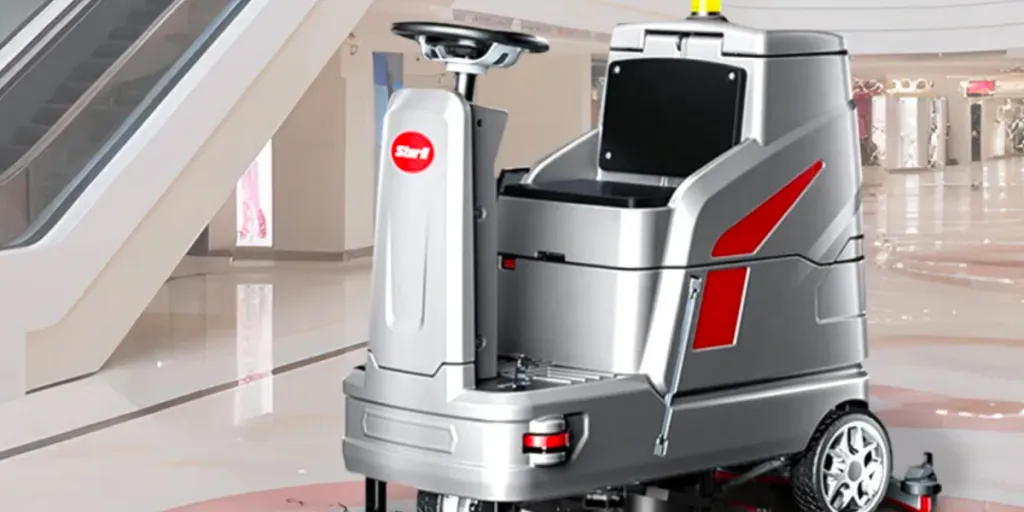Floor scrubbing machines come in a wide variety of choices, from walk-along pushing machines to ride-on versions, remote control versions, and even robot versions. This article looks at some of the choices available, their features and benefits, and offers some selection advice for the potential buyer.
Table of Contents
The projected global market for floor scrubbing machines
An introduction to floor scrubbing machines
What to consider when selecting a floor scrubber
Different types of scrubbing machines
Final thoughts
The projected global market for floor scrubbing machines
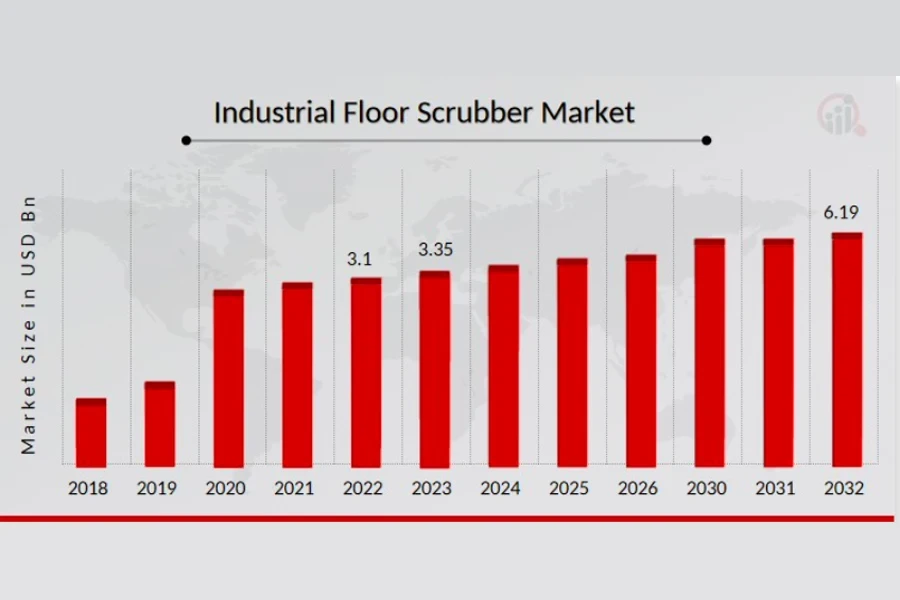
The global industrial and commercial floor scrubber market was valued at around US $3.1 billion in 2022, seeing quite a surge from 2018–19 due to the increased focus on industrial cleaning during the pandemic. That market is projected to grow at a very healthy and buoyant compound annual growth rate (CAGR) of 8%, from US $3.35 billion in 2023 to US $6.19 billion by 2032.
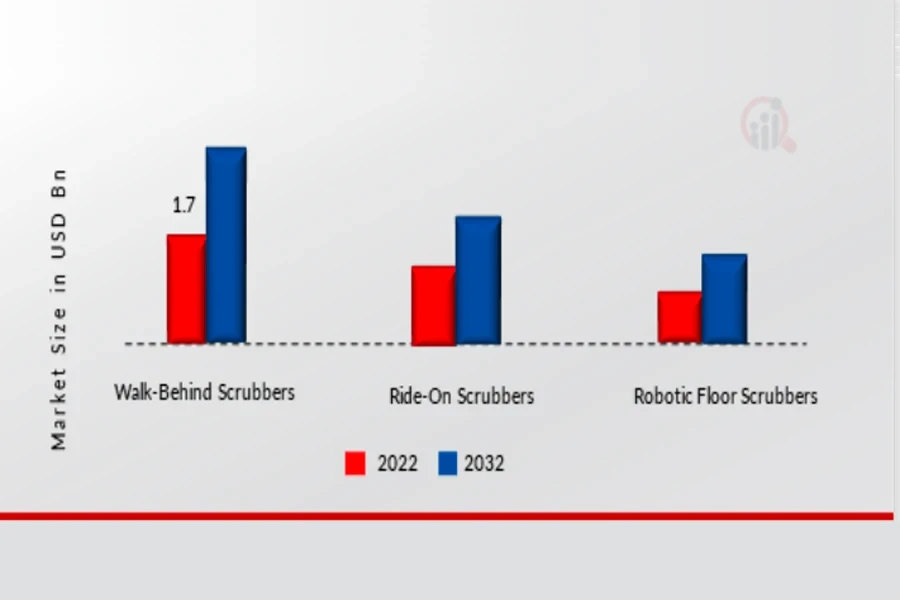
Walk-behind floor scrubbers took the majority of the market share in 2022, at around 35%, with a value of US $1.7 billion. They hold steady growth due to their convenience of size and mobility, making it easy to move them from floor to floor within a building. However, the increasing interest in intelligent and autonomous floor cleaners is leading to faster projected growth for robot scrubbers, as these are seen as a great option for frequent cleaning demands.
An introduction to floor scrubbing machines
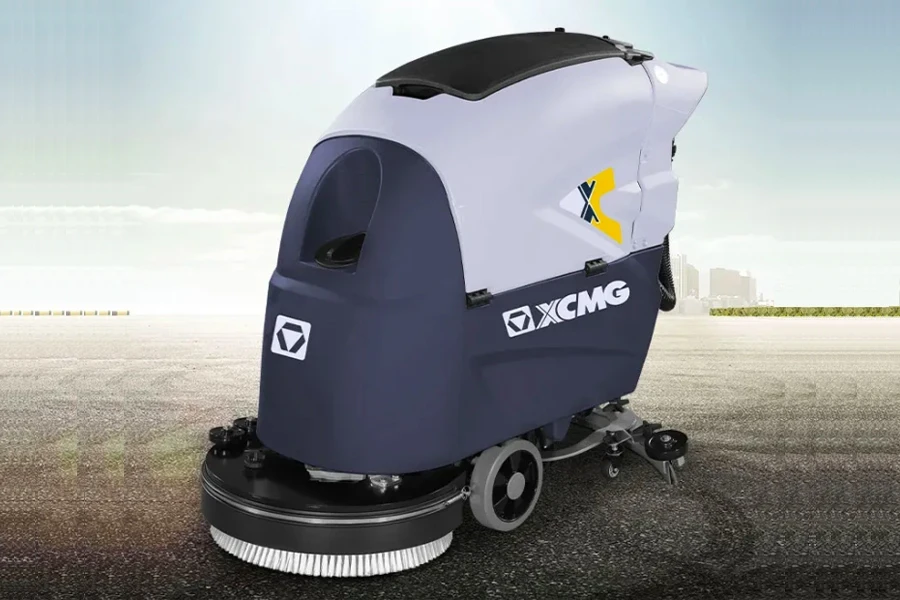
Floor scrubbing machines are floor cleaning machines that include a number of functions. The cleaning process involves removing dust and dirt, washing and scrubbing, vacuuming off the residue, and finishing the cleaned floor.
Floor scrubbers do not remove any layers of floor, as would a floor grinder, nor do they polish or buff the cleaned floor, as would a floor polisher. Floor grinders use an abrasive grinding disk (or disks) to remove the top layer of the floor, and floor polishers use a soft rotating disk to shine up the clean floor. So when looking at floor scrubbing features, it is helpful to know what they can do and what they cannot do.
Floor scrubbing machines are really the modern industrial equivalent of the old brush, mop, and bucket. The rotating brush provides a sweeping function to remove dust and dirt. Then clean water and a detergent or cleaning agent are dispensed from a fitted clean water reservoir. A rotating or oscillating head brushes the cleaning agent into the floor to remove stains.
The dirty water mix is then vacuumed up into a dirty water reservoir. Lastly, a sponge or squeegee-like fitting wipes up any remaining fluids to leave a fairly dry floor. All this happens in a single pass of the machine, so there is plenty going on in that one movement.
There are a variety of cleaning brush mechanisms available, including a rotating brush, a cylindrical brush, or a square oscillating style brush. As scrubbers are usually circular, they cannot get into room corners, but there are square-design versions of oscillating brush mechanisms that can work into corners well. Cylindrical brushes are able to collect objects from the floor, such as screws and other debris, and sweep them into a tray behind the cylinder.
Small scrubbing machines have a small cleaning area and are pushed along by the operator. Larger machines may have space for the operator to stand on, or they may be ride-on machines with a driver’s seat. There are remote control versions and fully automated “intelligent” robot-type machines.
So, with this range of features and capabilities, there are a few key designs, applications, and functions to consider in making a choice of which machine to buy.
What to consider when selecting a floor scrubber
For anyone looking to choose a floor scrubbing machine, there are a few factors to consider other than just budget.
Firstly, what is the nature and size of the job and the type of floor to be treated? Is this a floor that faces a light daily dirt build-up from footfall, or is it a heavy-duty industrial floor that faces oil and paint stains on a regular basis? This helps the buyer decide what sort of cleaning is required and how frequently.
What is the surface area of the floor—a large lobby area, a warehouse floor, a narrow corridor, or an entrance hall? The floor area will help determine the size of the scrubber and the required storage capacity of the clean and dirty water reservoirs.
The intended mobility of the floor scrubber also helps determine its size. If the floor scrubber is used to handle a large warehouse or factory floor only, then the machine may only be stored nearby for the next clean. However, if the scrubber is used on multiple floors within a high-rise building, then it needs to be able to fit easily into an elevator or even be carried up a staircase. If the scrubber is moved from one building to another nearby building, does it need to be carried by hand or lifted onto a truck? Then size and weight impact mobility.
Size, weight, and cleaning capacity then help narrow down the decision of whether a walk-behind machine will do the job or if a ride-on machine is a better choice. The choice of operator then also becomes a factor. A walk-behind machine will be light to operate but still require manual effort, whereas a ride-on machine will be easy to use and require very little manual effort.
Speed and frequency of cleaning come next. For larger areas where a fast clean is desired, then the ride-on models make sense. They have much larger water reservoirs and can clean a large surface area in a single operation. With a walk-behind, for a large area, this might be very tiring for the operator.
Finally, the amount of automation is a factor to consider, and this relates back to the budget. Where regular cleaning is needed and a hands-off operation is desired, then robot cleaners are a great solution. There are many models available in different sizes. They come at a much higher cost than other models, but there are cost savings from the reduced need for human intervention. When choosing a robot scrubber, check the range of sensors and automated features to ensure that the machine can operate and resolve obstacle issues with minimal intervention.
Different types of scrubbing machines
Walk-behind floor scrubbers
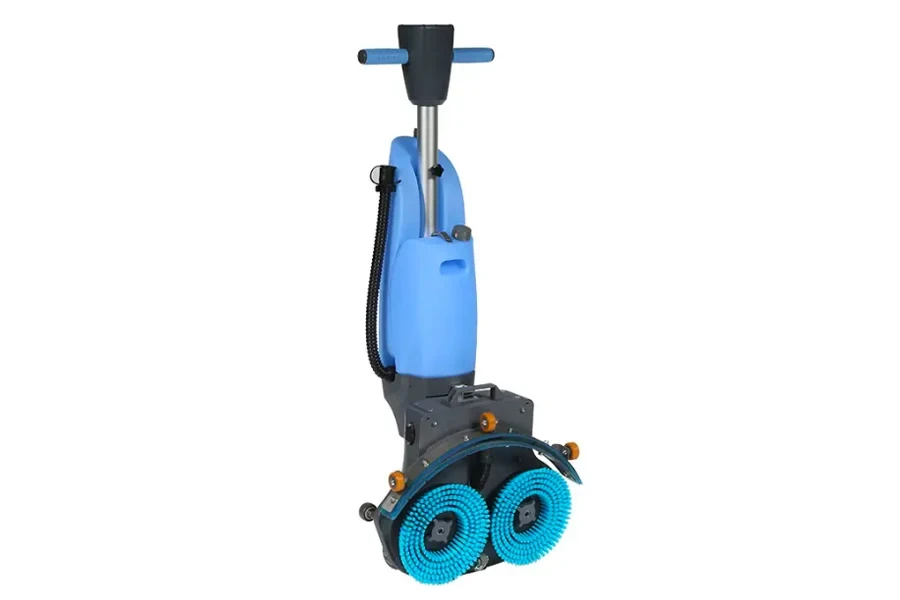
This compact floor scrubbing machine, shown with the cleaner folded, illustrates a number of the features of a typical hand-push, walk-behind machine. It is quite light at 50 lbs (24 kg), making it easy to carry and move around. It has double rotary brushes that clean to a width of 18” double.
The semi-circular fitting above the brushes is a 20.5” (520 mm) width squeegee that catches, contains, and absorbs water flow, leaving the floor fairly dry without water streaks. This model is designed for cold water cleaning and has two water reservoirs—a 6-liter clean water tank and a 9-liter dirty water tank. It is available for between US $530 and US $600, depending on the number of units ordered.
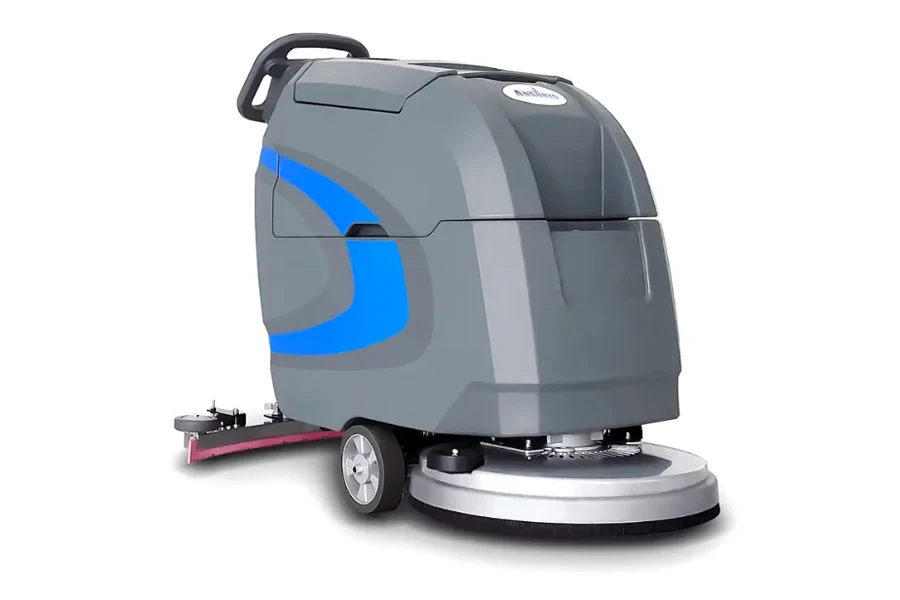
The model above is also a walk-behind, hand-push floor scrubber, but it looks quite different from the first. It has a single 20” (520 mm) rotary brush and large capacity water storage, as well as a 55-liter clean water tank and a 60-liter dirty water (sewage) tank.
It has a wide squeegee to catch trailing water for vacuuming. It is a much heavier machine, weighing between 400 and 440 lbs (180–200 kg), so it is not easy to carry but still moveable around a building and up and down in the elevator. This model is available for between US $751 and US $874, depending on order volume.
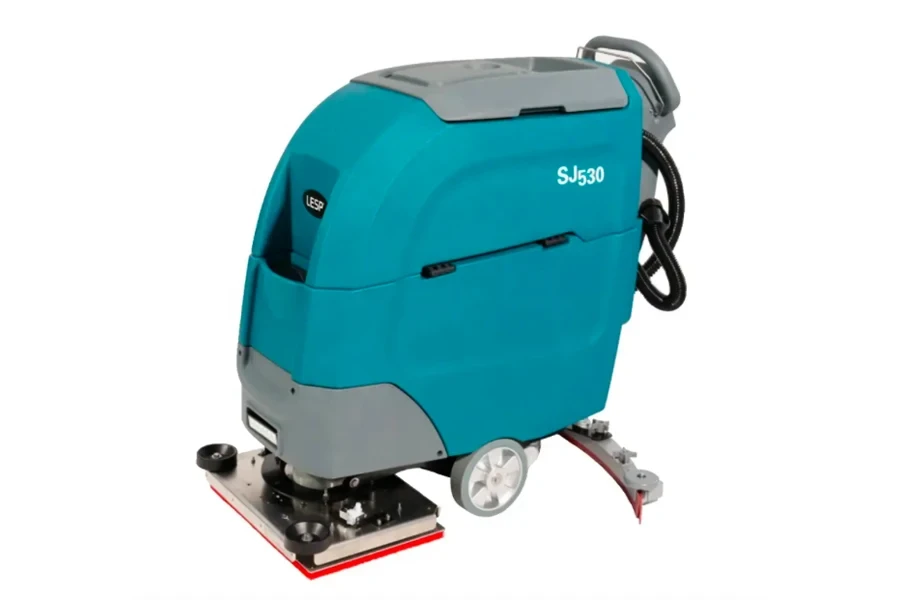
Similar in design to the previous model, this is also a high water capacity walk-behind floor scrubber. However, this model has a rectangular oscillating (vibrating) cleaning pad of dimensions 14”x10” (355 x 250 mm) instead of a rotary brush. This allows the machine to get into corners and angles to clean completely, which a rotary brush could not. It has a semi-circular squeegee with a 30” (780 mm) width.
This model has a 60-liter clean water tank and a 65-liter dirty water tank. It weighs up to 500 lbs (225 kg), with the weight being a factor of how much water it holds. This model is a hand-push, but it also has a self-propelled mode in which the operator can be “hands-off,” but there to guide and redirect the machine as it moves along. It can be ordered for between US $2,000 and US $750 for more than 10 units.
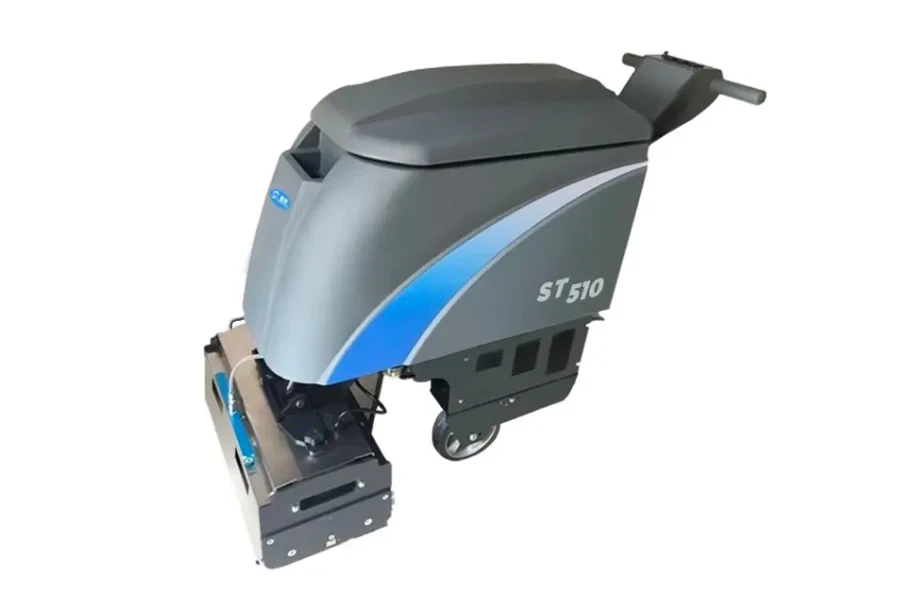
Cylindrical-model floor scrubbers are less common than the most popular rotary models, with this version advertised as suitable for cleaning escalator stairs. This model has a 20” (510 mm) wide cleaning cylinder with a 32-liter clean water reservoir and a 35-liter dirty water reservoir. This version is available for US $5,160.
Ride-on floor scrubbers

Ride-on scrubbing machines usually have two rear wheels and a single front wheel, with a seat and steering wheel for the operator and foot pedal power control, much like an electric car.
The above model has two rotary brushes, one on either side. Both have a 22” (560 mm) diameter, with the squeegee having a span of 37.5” (950 mm). The clean water tank holds 70 liters, and the dirty water tank holds 75 liters. This capacity gives it a very wide cleaning capability, which, together with the ride-on design, allows for fast cleaning across a wide area. The supplier suggests that an area of 6,330 sq ft (588 sq m) could be cleaned in under 10 minutes. This ride-on model, weighing 465 lbs (233 kg), is available for between US $1,557.78 and US $1,706.14.
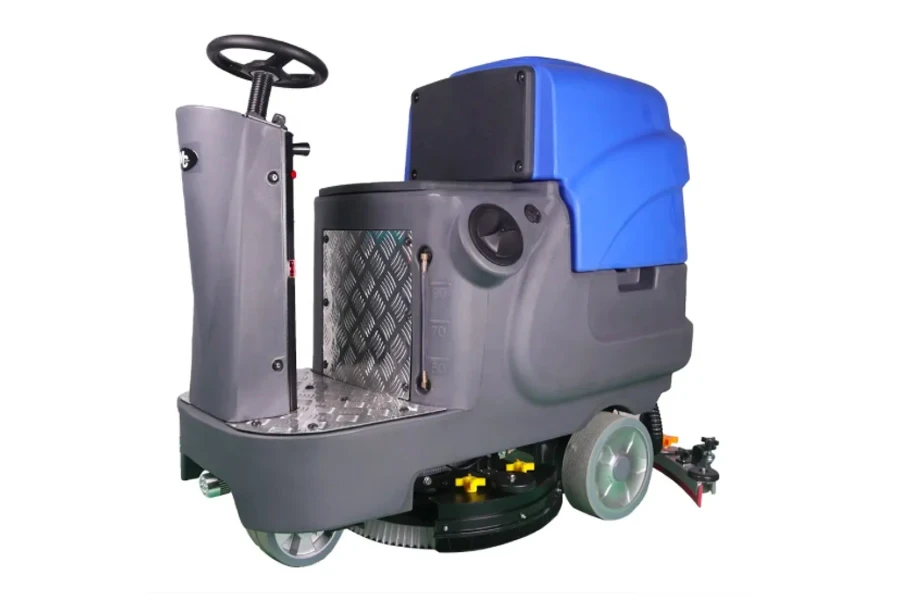
This version of a ride-on floor scrubber has one single large rotary brush measuring 22” (560 mm) and a squeegee width of 33.4” (850 mm). It has a large water storage capacity, with a 95-liter clean water tank and a 100-liter dirty water tank, and a three-stage suction motor. The overall weight of the machine is 507 lbs (230 kg), with full water tanks. The machine is supplied for between US $1,499 and US $1,999.
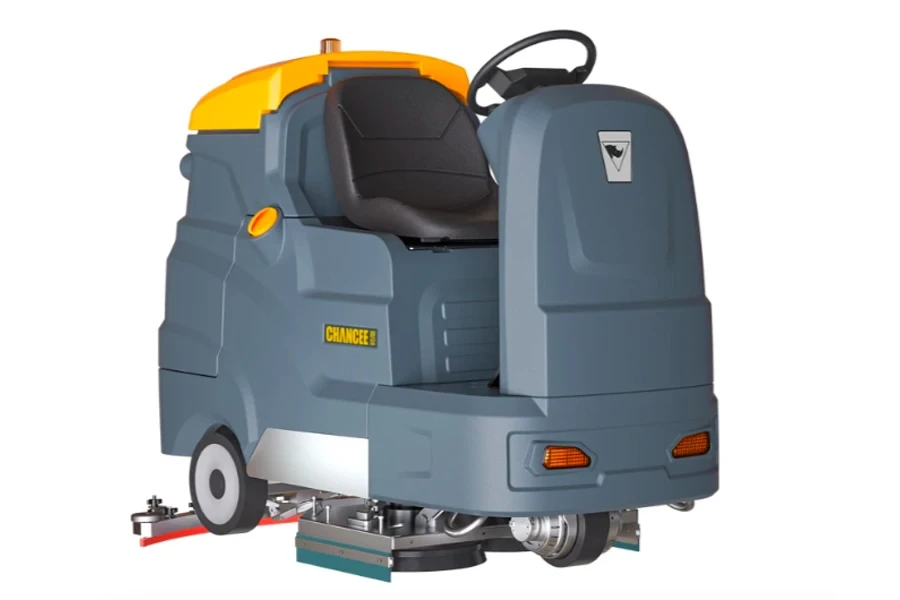
When a ride-on machine has a wide cleaning capacity and a large water storage system, it has the potential to clean a large area quickly in a single operation. This model has a wide cleaning capacity due to having two 17” (430 mm) and an exceptionally wide squeegee of 90.5” (1,200 mm).
It has a 240-liter clean water tank and a 260-liter dirty water tank with high suction power. It also has side skirts around the rotary brushes to contain water. The supplier suggests a cleaning speed of 86,100 sq ft (8,000 sq m) per hour, and this model is available for between US $5,450.60 and US $5,969.70.
Robot floor scrubbers
Robot cleaners are completely autonomous, and once programmed for their role and timing, they are capable of working without further human intervention, at least for a period of time. For the operator to allow the robot cleaner to carry out its work unattended, it needs to have a wide array of sensors to map and navigate cleaning areas, as well as to handle unexpected obstacles. This version is a good example with a variety of methods, including cameras, sensors, and mapping technology for environmental identification.
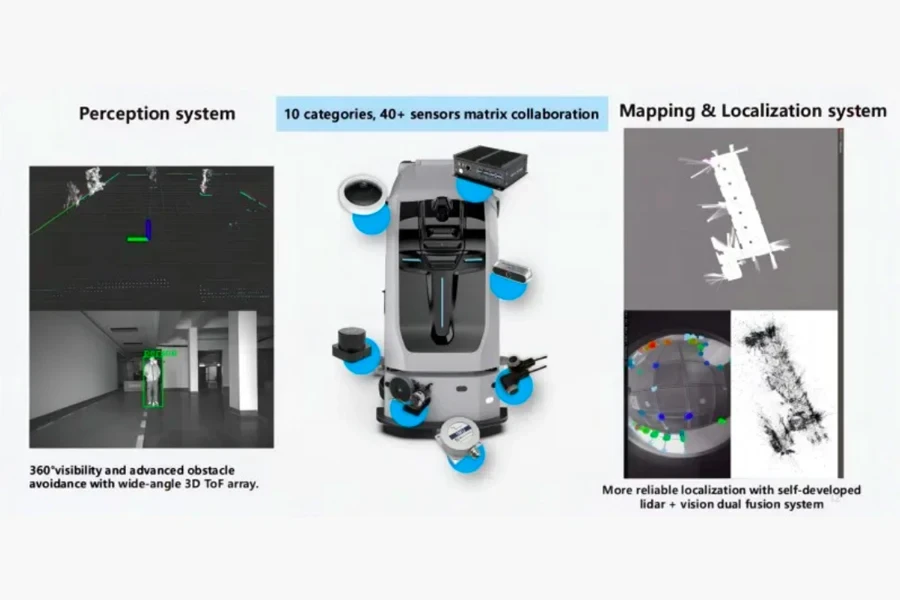
This robot version of a floor scrubber is a fully automatic, intelligent cleaner with a robot function. It has neither a handle for a hand-hold nor any space for a driver seat or steering wheel. It has a large digital display for setting and managing control of the robot.

It has a water capacity of 65 liters for clean water and 50 liters for dirty water, a 20” (510 mm) rotary brush, and a 30” (760 mm) squeegee. As with ride-on models, this is a cold water cleaner, and with a full battery, it can operate independently for 3–4 hours.
Perhaps not surprisingly, robot cleaners come at a higher investment than walk-behind and ride-on models, with this version available at between US $14,500 and US $15,000.
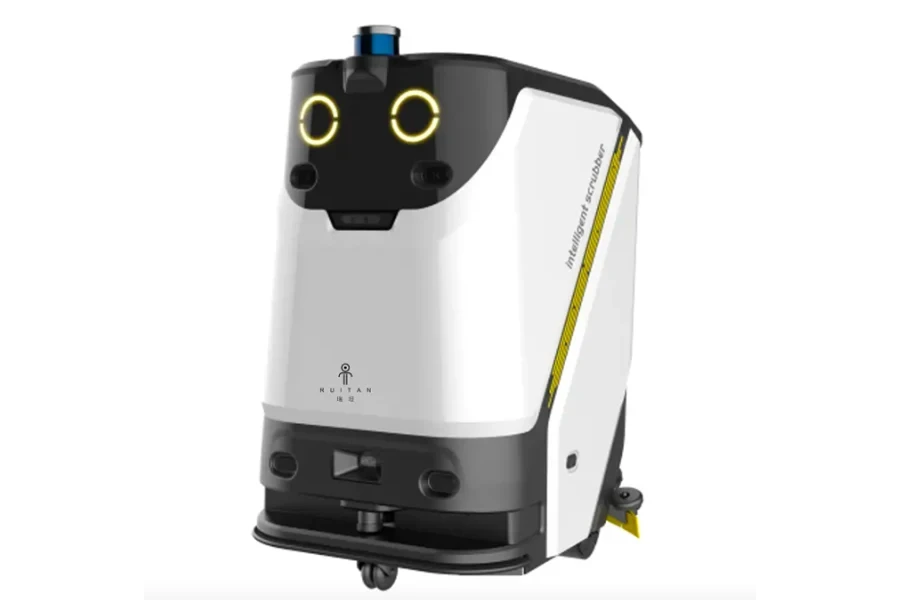
This robot floor cleaner is quite compact yet has a sizable rotary brush of 20” (500 mm) and a 24” (600 mm) squeegee. It is relatively slim at 33.5” (850 mm) overall, and with a total weight of 330 lbs (150 kg), it can be easily moved to different building floors. This model is available for between US $18,000 and US $18,331 depending on order volume, and can be requested with a number of additional features for an additional cost.
Final thoughts
When looking for a floor scrubber, there are plenty of choices with a wide range of functionality and associated prices. The main designs are walk-behind, ride-on, or autonomous robot machines.
The scale of the job at hand is a key consideration, as is the amount of operator involvement. Walk-behind machines do need the operator to move the machine around, and this does take some effort, but these scrubbers are fairly small and can be moved manually up and down the floors within a building, and smaller scrubbers may even be lifted by hand.
For larger areas, ride-on models may make more sense. They can clean large areas quickly with minimal manual effort, and because they have a much larger water capacity, they can clean in a single operation. Their larger size and weight (partly due to the amount of additional water storage) make them less mobile in smaller access areas, and they may not fit into an elevator for multiple floors.
Robot cleaners are becoming more available in different sizes, but they do come at a much higher cost than other types. However, this cost may be offset by the reduced need for manual involvement. The technical sophistication of the robot sensor systems is important to ensure that the scrubber can properly sense obstacles and resolve situations without operator involvement.
The potential buyer has plenty of choices to fit their desired functionality and budget. For more information, check out the online showroom at Chovm.com.
